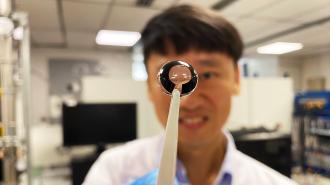Scientists in Singapore have invented a new flexible battery that could power safe, comfortable smart contact lenses — partially charged by our tears.
Smart contact lenses: Contact lenses equipped with tiny displays could change how we see the world, allowing us to tap into the potential of augmented reality (AR) without having to wear bulky glasses everywhere we go.
Smart contact lenses could also help us stay healthy by dispensing drugs or monitoring our eyes for signs of diseases, such as glaucoma and diabetes.
“[T]he smart contact lenses industry has been looking for a thin, biocompatible battery.”
Murukeshan Vadakke Matham
This tech really exists — as prototypes. But to move out of the lab and into our eyes, the lenses need a safe power source that doesn’t affect their function or wearability, and researchers haven’t quite figured out that part of the equation.
“The most common battery charging system for smart contact lenses requires metal electrodes in the lens, which are harmful if they are exposed to the naked human eye,” said Yun Jeonghun, co-first author of the new study from the Nanyang Technological University (NTU) in Singapore.
“Meanwhile, another mode of powering lenses, induction charging, requires a coil to be in the lens to transmit power, much like wireless charging pad for a smartphone,” he continued.
What’s new? The NTU researchers have now unveiled an ultra thin, flexible battery that doesn’t contain any wires or toxic heavy metals. It’s coated in a glucose-based material that reacts with the molecules in saline solution in a way that generates electricity and charges the battery.
Molecules in a person’s own tears can charge it, too, though not enough to eliminate the need for a regular soak in saline solution — according to testing with simulated eye tears, for every 12 hours of wear, a person’s natural eye moisture would add an extra hour of charge.
In testing, the flexible battery produced a max power of 201 microwatts, which the researchers say would be enough to send data from smart contact lenses for 12 hours. It was also robust enough for 200 charging cycles.
Looking ahead: So far, all the researchers have is a battery — they haven’t shown how it could be incorporated into smart contact lenses capable of doing any of the futuristic things we want to use them for.
The next steps are working to increase the amount of current the flexible battery can discharge and collaborating with several companies to incorporate the tech into smart contact lenses.
“[T]he smart contact lenses industry has been looking for a thin, biocompatible battery that does not contain heavy metals, and this invention could help further their development to meet some unmet needs of the industry,” said Murukeshan Vadakke Matham, an associate professor at NTU who specializes in biomedical and nanoscale optics and was not involved in the study.
We’d love to hear from you! If you have a comment about this article or if you have a tip for a future Freethink story, please email us at [email protected].






